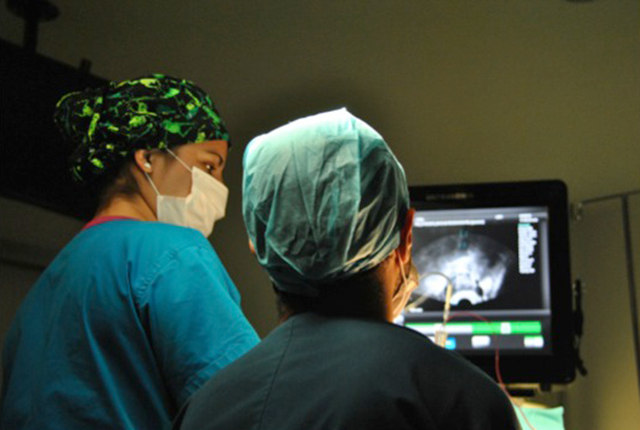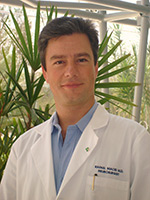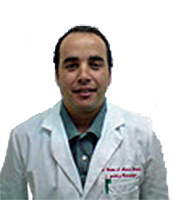NEUROSURGEON
Minimally invasive Neurosurgery techniques:
- Neuroendoscopy for intraventricular procedures, endoscopic assisted surgeries
-
- Endoscopic pituitary adenoma resection
-
- Stereotaxic and neuronavegation surgeries
-
- Functional surgery
-
- Radiosurgery experience with LINAC and Gamma Knife
-
NEUROSURGERY RESIDENCY
Nacional Medical Center "20 de Noviembre ISSSTE", México City Generation 2007
Title by Mexican Autonomous National University
Specialist License Number: 4991249
BOARD CERTIFIED, MEXICAL ASOCIATION OF NEUROLOGICAL SURGEONS Certificate Number: 811
ALLGEMEINES KRANKENHAUS – UNIVERSITÄTSKLINIKEN Vienna, Austria
Visiting M.D. in Functional Neurosurgery and Neuronavegation
JHO INSTITUTE OF MINIMALLY INVASIVE NEUROSURGERY Pittsburgh, USA
Fellow in Neuroendoscopy and Minimally Invasive Neurosurgery
MASTER IN NEUROSCIENCE AND BEHAVIOUR BIOLOGY University of Pablo de Olavide, Sevilla Spain
DIPLOMA IN HOSPITAL FINANCES AND ADMINISTRATION UNAM, Faculty of Superior Studies Campus Iztacala/p>
RESEARCH BACKGROUND
Experimental Microsurgery in animals
Institution: Proyecto Camina
Protocol: Spine regeneration with peripheral nerve or embryo spine trasplanstation in traumatic spine injury in rats
Date: August 1996 to June 1997
Social Service in Research
Institution: Proyecto Camina
Protocol: Spine regeneration with activated macrophagus trasplanstation in traumatic spine injury in rats
Date: August 1998 to June de 1999
Neurosurgery Final Tesis
Institution: ISSSTE
Clinical and Radiological Analysis of Pituitary Adenomas treated with Radiosurgery and
Fractionated Conformational Stereotactic Radiotherapy. Date: November 2006 to February 2007
TEACHING EXPERIENCE Lectures: Neuroanatomy fr Psycologist
School of Psycology. Anahuac University, Cancun. from August 2013 to October 2012
Lectures: Clinical Neurology, Neuroanatomy and Neurophysiology
Institution: Proyecto Camina, from August 1998 to June 1999
6. Seminarios /Congresos
Lectures
CNS Anatomy and Neuroblastoma
2th Medical Sanitary District, Cancun Qroo. 21 and 22 July 2011
Traumatic brain injury: Surgical treatment
I Medical Jornal 2009, HGR#17 IMSS Cancun Qroo. October 21 2009
Minimally Invasive Neurosurgery
III Academic Jornals, Quintaroo College of surgeons. Cancún Qroo. October 2nd 2009
Stereotactic and Neuronavegation "hand on workshops" (Organizer and Professor)
XX Mexican Neurological Surgeons Meeting, Galenia Hospital. Cancun Qroo. July 19 2009
Minimally Invasive Neurosurgery
Academic lectures, Galenia Hospital. Cancun Qroo. March 26 2009
Minimally Invasive Neurosurgery
Academic lecture. Amerimed Hospital. Cancún Qroo. November 26 2008
Brain Death Diagnosis
II Cancun Simposium "No step back" Organ Transplantation. Cancún Qroo. Oct 9 2008
Stereotaxy and Radiosurgery
Atizapan General Hospial, Mexico City. August 28 2008
Minimally Invasive Neurosurgery
Academic lecture, Cozumel Medical Center. Cozuel January 15 2008
Psichiatric Neurosurgery
Anahuac University, Cancun. November 22 2007
Minimally Invasive Neurosurgery
General meeting, General Hospital Cancun. October 23 2007
Minimally Invasive Neurosurgery
Academic lecture, Galenia Hospital. Cancun. October 10 2007
Neuroendoscopy
General meeting. General Hospital Cancun. July 20 2008
Neuroendoscopy
Neurosciences lectures. CMN 20 de Noviembre ISSSTE, Mexico City. January 3 2007
Clinical, Endocrinological and Radiological Analysis of Pituitary Adenomas treated with Radiosurgery and Fractionated Conformal Stereotactic Radiotherapy: Preliminary Report (presentation in English)
XXV International Course of Pituitary Adenomas, CMN 20 de Noviembre ISSSTE, Mexico
City. November 28 2006
Endoscopic Neurosurgery
XL Medical Meeting, Sociedad Médica Clínica Londres A.C. Mexico City. Nov. 24 2006
Adenomas de Hipófisis. Neurologic and Neurosurgical patient intensive course. CMN 20 de Noviembre, ISSSTE., Mexico City. October 24 2006
Minimally Invasive Neurosurgery
Ex-Nicolaitas Students Society, II Academic Meeting. Uruapan, Mich. October 12 2006
Arteriovenous Malformations and alternative treatments
Mexican Society of Neurological Surgery. Mexico City. March 7 2006
Neuromodulation
Mexican Society of Neurological Surgery. Mexico City. February 6 2006
Minimally Invasive Neurosurgery
La Sociedad de Ex alumnos Nicolaitas, 2da. Jornada Medica. Maravatio, Mich. July 5 2005
Advances in Radiosurgery
V Meeting of Neurocience Residents, CMN 20 de Noviembre , Mexico City. June 6 2004
Gamma Radiosurgery, 8 years in Mexico
IV Meeting of Neurocience Residents, CMN Siglo XXI, Mexico City. September 12 2003
Gamma Radiosurgery in Mexico
III Meeting of Neurocience Residents, CMN Siglo XXI, Mexico City. July 26 2002
Stereotactic surgical tecniques
V Academia week. Anahuac University, Mexico City. April 14 1999
Experimental paraplegia, experience in Proyecto Camina
III Academic week. Anahuac University, Mexico City. April 24 1997
Neurosurgical treatment of Epilepsy
I Academic week. Anahuac University, Mexico City. April 23 1995
Face Congenital Malformations
Academic meeting. Anahuac University, Mexico City. March 131994
MEETINGS AND COURSES
Eurospine 2011 Annual Meeting
Milan, Italy. October 19 to 21, 2011
International Course of Motion Preservation
Florence, Italy. October 17 to 18, 2011
XII National Meeting of AMCICO
AMCICO (Mexican Society of Spinal Surpeons)
Cancun Qroo. July 23 to 25, 2011
XXIV International Intradiscal Therapy Society (IITS)
Cancun Qroo. July 23 to 25, 2011
79th AANS Annual Meeting
Denver, Colorado. April 9 to 13, 2011
XXXIII Mexican Association of Neurology Annual Meeting
Cancún Qroo. November 15 to 21 2009
4th Annual Northwestern Radiosurgery Symposium
Northwestern Memorial Hospital, Chicago IL, USA. September 25 2009 (6.5 Credits)
XIV World Congress of Neurological Surgery
Boston MA, USA. August 30 to September 14 2009
XX Mexican Neurological Surgeons Meeting
Cancún Qroo, July 19 to 24 2009
Stereotactic and Neuronavegation "hand on workshops" (Organizer and Professor)
XX Mexican Neurological Surgeons Meeting, Galenia Hospital. Cancun Qroo. July 19 2009
Congress of Neurological Surgeons 58th Annual Meeting
Orlando FL, USA. September 20 to 25 2008 (24.50 credits)
Schloffer Conference and International Society of Pituitary Surgeons Meeting 2007
AKH Vienna Austria. September 7 to 10 2007
Master in Neurosciences and Behaviour Biology
Pablo de Olavide University, Sevilla Spain. January 2007 to October 2007
Member of "The Internacional Neuroendoscopy Study Group"
Pittsburg, EU. August 2006
Diploma in Hospital Finances and Administration
UNAM, Faculty of Superior Studies campus Iztacala. October 2005 to May 2006 (200 Hrs)
1st Minimally Invasive Neurosurgery International Meeting
Guadalajara General Hospital, April 24 to 29 2006 (20Hrs)
Workshop of Neuroendoscopy, Neurosonografy, Neuroendovascular Therapy
Guadalajara General Hospital, April 24 to 29 2006 (30Hrs)
I National Meeting of Neuroendoscopy
Mexican Society of Neurological Surgery. Mexico City. November 18 to 19 2005
European Workshop on Basic Techniques of Microsurgery and Cerebral
Revascularization
Medical University of Vienna, Austria. (AKH). October 21 to 26 2005
Selected topics in Neurocience
CMN 20 de Noviembre, ISSSTE. Mexico City. March 15 to 17 2005 (20 hrs)
Update in Gamma Knife
Médica Sur. Mexico City. November 11 to 14 2004 (15 hrs)
72nd ANNS Annual Meeting
Orlando Florida. May 1 to 6 2004 (21 credits)
XVII Mexican Meeting of Neurological Surgery
Monterrey N.L., July 19 to 25 2003
PUBLICATIONS
Maciel Rafael, Baltazar Jorge, Ramírez Vicente, González Armando y Cols. Técnicas Neuroendoscópicas: Indicaciones y procedimientos.
Revista de Especialidades Médico-Quirúrgicas Volumen 11, Num.3 Destrezas Clínicas. Pag. 63-67.
Maciel Rafael, Ramírez Vicente, Gonzalez Armando, Valdez Evangelina
Análisis Clínico, Endocrinológico y Radiológico de los Adenomas de Hipófisis Tratadas con Radiocirugía y Radioterapia Estereotáctica Conformacional Fraccionada: Estudio Preliminar.
Revista Mexicana de Neurociencias 2006: Volumen 7 Num. 2 Pag.573-580
Maciel Rafael, Baltazar Jorge, Garcia Silvia, Armando Gonzalez y cols.
Biopsia guiada por referencias anatómicas en una paciente con Leucoencefalopatía Multifocal
Progresiva (LMP).
Revista de Especialidades Médico-Quirúrgicas Volumen 10, Num.1 Destrezas Clínicas. Pag. 74-78.
7. Hospital(es) en donde atiende (destino Cancún, RM, Playa del Carmen)
PUBLIC PRACTICE
CANCUN GENERAL HOSPITAL "JESUS KUMATE RODRIGUEZ"
Cancun, Qroo.
PRIVATE PRACTICES
GALENIA HOSPITAL
Office 209, Cancún Quintana Roo
MÉDICA DEL CARMEN
Playa del Carmen Quintana Roo
COZUMEL MEDICAL CENTER (CMC)
Cozumel Quintana Roo.
RELEVANT PROCEDURES DONE IN CANCUN:
More than 600 neurosurgical procedures since I arrived to Cancun 6 years ago (May 14th, 2007).
40% of the cases are Brain, 60% spinal
problems.
PIONER IN THE SOUTH OF MEXICO, performing the First Neuronavegaction, stereotatic, neuroendoscopy, DBS surgery for Parkinson and distonía, Endoscopic pituitary adenoma resection in Cancun and the South of Mexico.
8. Acreditaciones y credenciales
MEMBER OF SOCIETIES AND GROUPS: Mexican Society of Neuroloical Surgery A.C.
Active Member
European Society for Stereotactic and Functional Neurosurgery (ESSFN)
Active Member
The Internacional Neuroendoscopy Study Group, Pittsburg, EU.
Active Member
European Association of Neurological Surgeons (EANS)
Active Member, Member Number 0570
American Association of Neurological Surgeon (AANS)
Active Member, October 2007
International Society of Pituitary Surgeons Meeting (ISPS)
Active Member
The Congress of Neurological Surgeons (CNS)
Active Member
NEUROSURGERY RESIDENCY
Nacional Medical Center "20 de Noviembre ISSSTE", México City
Generation 2007
Title by Mexican Autonomous National University
Specialist License Number: 4991249
BOARD CERTIFIED, MEXICAL ASOCIATION OF NEUROLOGICAL SURGEONS
Certificate Number: 811


